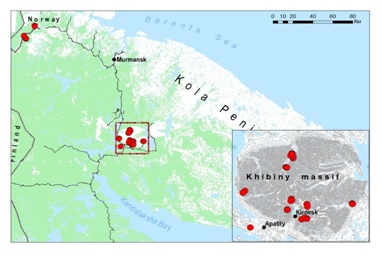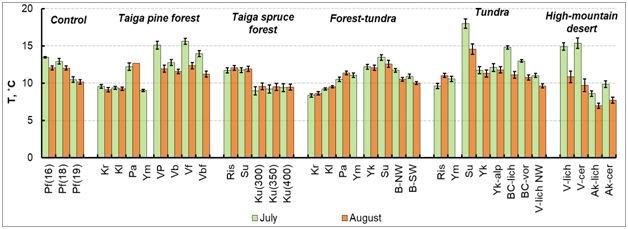The author(s) will give a talk
Creating a database of mountain soil temperature on the subarctic Kola Peninsula
1 Institute of Industrial Ecology Problems of the North Kola Scientific Center of the Russian Academy of Sciences
2 Institute of Industrial Ecology Problems of the North Kola Scientific Center of the Russian Academy of Sciences
Mountain ecosystems are centers of increased biodiversity due to a combination of environmental conditions such as slope exposure, altitudinal zonation of the soil cover, formation of ecotones and azonal communities, special microclimate, movement of air masses, and the presence of temperature inversions. For the Khibiny massif, such biodiversity was studied almost 100 years ago at the Tietta Mountain Station and repeatedly confirmed by subsequent studies. At the same time, polar mountains and their biota are vulnerable to the influence of natural and anthropogenic factors including climatic changes occurring in high-latitude areas in recent decades, and are indicators of such impacts. In particular, the altitudinal movement of forest boundaries in Khibiny and Subpolar Urals is a response to an increase of average annual air temperatures.
The nature of the temperature distribution in the outer layer is also an indicator that temperature affects the rate of biological, physicochemical, and biochemical processes in the soil, determines the growth and development of living organisms and their vital activity, and ultimately leads to an increase and improvement in soil biota, i.e. soil biodiversity. The greatest fluctuations in temperature are observed in the surface layer of the soil – the organic horizon or litter, the most populated biota. In recent years, studies have been carried out on the temperature regime of mountain soils in the Murmansk region using a new generation of autonomous, programmable “automatic tablets”.
In the territory of the Murmansk region the study of the soil temperature was performed in natural forest and cultivated podzolic and peat soils [4,5], both in the Khibiny mountain massif [3] and in the mountains of the Pasvik Nature Reserve [2].
The Khibiny massif is located in the north-west of the European part of Russia - in the Murmansk region (Fig.1), which geographically covers the territory of the Kola Peninsula and part of the mainland. The Khibiny area is estimated at 1300 km2, which is 0.89% of the total area of the Murmansk region, equal to 144.9 thousand km2 [1]. The goal of the research is to study temperature dynamics (daily, seasonal, and year) in mountain soils, taking into account factors of altitudinal zonality of soil and vegetation cover and dependence on slope exposure.
Main tasks:
- Comparison of litter’s temperature parameters in altitude gradient, in the main mountain belts, and with an elevation rise for every 50 m above sea level.
- Comparison of litter’s temperature parameters in mountains ecosystems on a plateau and on slopes of different exposition.
- Comparison of obtained data on soil temperature with meteorological data and own data on the air temperature.
- Analysis of the dependence of the mountain soils temperature of organic matter content.
- Analysis of diversity and distribution of soil invertebrates fauna in dependence on the temperature regime of mountain soils and organic matter content.
- Comparison of temperature dynamics in the mountain and zonal lowland forest soils.
In recent years: the different modifications of autonomous, compact sensors (loggers) are widely used in field soil researches. The electronic “tablets” for prolongation autonomic registration of temperature and humidity after the programming on a personal computer.
In field research in mountain ecosystems we are using the TR-1, TR-2, and TRV-2 sensors:
- for measurement of air temperature at the altitude of 2 m above ground
- for measurement the temperature on the soil surface in different mountain belts
- for measurement of the soil temperature at a depth of 5 cm in different mountain belts.
The object of the study is the temperature of mountain soils in the thickness of the litter with the help of automatic thermohydrochrons TRV-2 with a maximum measurement range of -25 ... +40 ° C.
The sensors were installed at a depth of 5 cm and programmed to register the temperature every 2 hours (daily dynamics). The daily average, monthly average, and average values for the growing season (July-August) were calculated.
To date, the database contains information about the temperature of 2 mountain ranges (Khibiny Mountains, 67°44 05" N 33°43 34" E, and Pasvik Nature Reserve, 69°04 00" N 29°11 10" E) and foothill plain pine forest (control).
For most of the studied biotopes, the following data were obtained: annual, monthly, summer, and intraday dynamics.
Calculated parameters in the database: average temperature values, minimum and maximum values, amplitude, temperature variability, the sum of positive and negative, the number of days with temperatures above +10, +5 and 0
To date, studies have been carried out for 14 mountain ecosystems and 1 control area.
For the majority of the investigated habitats (of 47) received the temperature data mountain litter (organic horizon) for annual, monthly, and year intraday dynamics for major mountain belts Khibiny – high-mountain desert, tundra, forests tundra, taiga (spruce and pine forest).
All areas on the graph are located near the main mountain-vegetation belts of the Khibiny. A flat northern taiga pine forest present as a control area.
In the control plot with zonal soil type, the average temperatures of litters in the summer season (July - August) are higher in 2016, this is associated with a significantly warmer year (F> 18.2 p = 0.001).
In the ecosystems of the mountain-taiga belt (221-310 m above sea level), the average monthly temperatures of the litter are the highest in the treeless areas of the intermountain valley as compared to the mountain ones. Anthropogenic areas warm up better since there is a sparseness of the stand, the absence of crowns and moss-dwarf shrub layer, and better heat absorption by the dark soil surface, colored with ash elements.
In the ecosystems of the mountain-tundra belt (430–800 m above sea level) and in the belt of crooked birch forests, the slope exposure factor has a differentiating effect on differences in average monthly in the warmest month - July (reliability of differences in average monthly July in litters; reliability differences in temperature dynamics; the number of days with effective ? ? +10 º?; the sum of positive temperatures in the litter). The litter of the slopes of the western and southern exposure warms up better.
For the belt of birch crooked forest, the influence of the height above sea level sea (340-460 m above sea level. m.) on the difference in mean monthly temperatures is not obvious.
The differentiating influence on the temperature regime of mountain litter is mainly exerted by 3 factors: "seasonality", "slope exposure", and "altitude zonation".
The seasonality factor is the main factor that determines the change in atmospheric air temperature. This affects the warming of the litter (in spring) and its cooling (in autumn). Thus, the seasonal change in the processes of heat absorption by the litter and its radiation.
Altitudinal zonality determines significant differences in temperatures of the monthly average, minimum and maximum intraday, and average summer temperatures in litters; differences in the dynamics of average daily temperatures, in seasonal variability, in the timing of the transition through the average daily temperature <+5 º? at the end of the growing season (in September). These differences appear for the mountain-forest and mountain-tundra belts throughout the growing season, and they increase from July to September, that is, they are also subject to the influence of the seasonality factor.
The exposure of mountain slopes determines the differences in such parameters of the litter temperature regime as monthly average and maximum temperatures, the number of days with effective ? dayav > +10 and <+10 º?, the sum of positive temperatures in the litter.
However, a significant differentiating effect of this factor was established for the litters of the mountain-tundra and the belt of birch crooked forests only in the warmest month of the growing season - July.
Atlas of the Murmansk region, 1971, Moscow, Research Institute of Geography and Economics, Leningrad State University. A.A. Zhdanova. p.34.
Zenkova, I.V., 2013, Summer temperature dynamics in mountain soils of the Pasvik reserve // Vestnik MSTU. Proceedings of the Murmansk State Technical University, ?.16. ?4. p. 715 – 724.
Zenkova, I.V., 2015, On the characterization of the summer dynamics of litter temperature in the mountains of the Khibiny massif (Murmansk region), Fundamental and applied issues of forest soil science: Proceedings of the VI Russian scientific conference on forest soil science with international participation, Syktyvkar: Komi Scientific Center of the Ural Branch of the Russian Academy of Sciences, p. 85-87.
Kryuchkov, V.V., 1958, Factors Determining the Upper Limits of Vegetation Belts in the Khibiny Mountains, Botanich. Journal, ?.43. ? 6. p. 16.
Yakovlev, B. A., 1961, Climate of the Murmansk region, Murmansk, Murmansk book publishing house, p. 200.

Fig 1.
Location of the Khibiny massif

Fig 2.
Summer temperature dynamics in 47 mountain sites and 1 zonal studied during 2012-2018